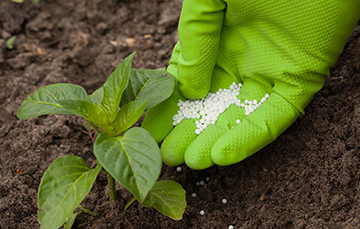Major types of fertilizer also called all that series of mineral or organic compounds that provide necessary elements for plants.It is necessary to provide all the elements according to the needs of each plant. The lack of one nutrient can never be overcome with the excess of another.
Types OF Fertilizer In Plant Agriculture
1 Organic fertilizer based on organic matter
Organic matter produces the following effects in a soil:
- It improves the physical structure of the soil , giving looseness to heavy soils and making the sandy or loose ones compact. Also because it has an acidifying effect, it reduces problems in soils with a lot of limestone or high pH.
- Activate the biological life of the soil , making the processes that take place in it, are favored and faster.
- It forms the humus , which is the main fertility factor of a soil.
- When the organic material decomposes, it leaves free in the soil, all the nutritive elements that will be used to feed the plant and also enrich the soil that is becoming impoverished.
It is essential, therefore, to make contributions of organic matter to the soil , so that the soil has the reserves of elements that allow it to preserve its fertility, in addition to providing the necessary nutrients to the plant. It is advisable to make these contributions every season, as this will establish a greater balance in the field.
2.Nitrogen fertilizers
Nitrogen fertilizers provide up to 50% of the total yield increase obtained from complete mineral fertilizer. The application of 1 kg of nitrogen mineral fertilizers provides an increase in yield: 8 … 15 kg of grain, 50 … 70 potatoes,20 … 30 hay of meadow grasses, 30 … 40 – sugar beet roots, about 3 kg of flax fiber.
The share of nitrogen fertilizers accounts for 6 … 7 million tons of nutrients, which is 42 … 44% of the total production of mineral fertilizers.Studies have shown that in field conditions in the year of planting only 30 … 50% of nitrogen fertilizers are used, 25 … 45% of nitrogen is fixed in the soil in an organic form, and 10 … 30% is irrevocably lost from the soil.
Depending on the form of the nitrogen compound contained in the fertilizer, they are divided into the following types: nitrate, ammonium and ammonium, ammonium nitrate, amide. In addition, nitrogen fertilizers can be represented by mixed forms (ammoniates and CAS).
3.Nitrate fertilizers – contain nitrogen in the nitrate form: NaN0 3 sodium nitrate and Ca (N0 3 ) 2 – calcium nitrate. They are a byproduct of the main chemical production and constitute a small proportion (less than 1%) of nitrogen fertilizers produced. Physiologically alkaline fertilizers contain 16 and 13% nitrogen, respectively.
4.Ammonium and ammonium fertilizers – contain nitrogen in ammonium (NH 4 ) or ammonium (NH 3 ) form. These include ammonium sulfate – (NH ^ SC ^ with 21% N content, ammonium chloride – NH 4 C1 with 25% N content, ammonium sulfate – sodium – (NH 4 ) 2 S0 4 with 16% N content, ammonia water – NH4OH with a content of 18 … 20.5% N and anhydrous ammonia — NH 3 with a content of 82.3% N.
5.Ammonium nitrate fertilizers – contain nitrogen in ammonium and nitrate forms. These are ammonium nitrate – NH4NO3 with a content of 34.5% N and lime-ammonium nitrate —NH4NO3 • СаС0 3 with a content of 26 … 28% nitrogen.
One of the most common nitrogen fertilizers (it accounts for 36% of all nitrogen fertilizers produced). Universal fertilizer, it can be applied under any crops on all soils and at any time.
6.Amide fertilizers contain nitrogen in the amide (NH 2 ) form. This type includes urea or carbamide – CO (NH 2 ) 2 with a content of 46% N. This is a universal fertilizer, which accounts for 35% of all nitrogenous fertilizers.
7.Mixed forms of nitrogen fertilizers are represented by mixtures of aqueous solutions of ammonium nitrate, urea, and other forms of nitrogen fertilizers. This species includes ammonia – solutions of ammonium nitrate and urea in aqueous ammonia.
8.UAN – aqueous solutions of ammonium nitrate and urea with a content of 28 … 32% N are widely used abroad, they began to be produced in our country, and by 2010 they should take the second place among the produced nitrogen fertilizers.
The use of CAS in agriculture has undoubted advantages over solid fertilizers: complete mechanization of all loading and unloading operations is ensured, losses are dramatically reduced, production and use costs are reduced, working conditions are improved, tare consumption and caking are eliminated, high nitrogen uniformity is provided, cooking necessary fertilizer mixtures, including the addition of trace elements and pesticides.
8.Fertilizers Chemical fertilizers are generally fast acting and stimulate plant growth and vigor when applied.
These fertilizers are grouped into different types according to the substances they provide:
– Nitrogenates
– Phosphoric
– Potassium
– Complexes
– Binaries
– Etc.
